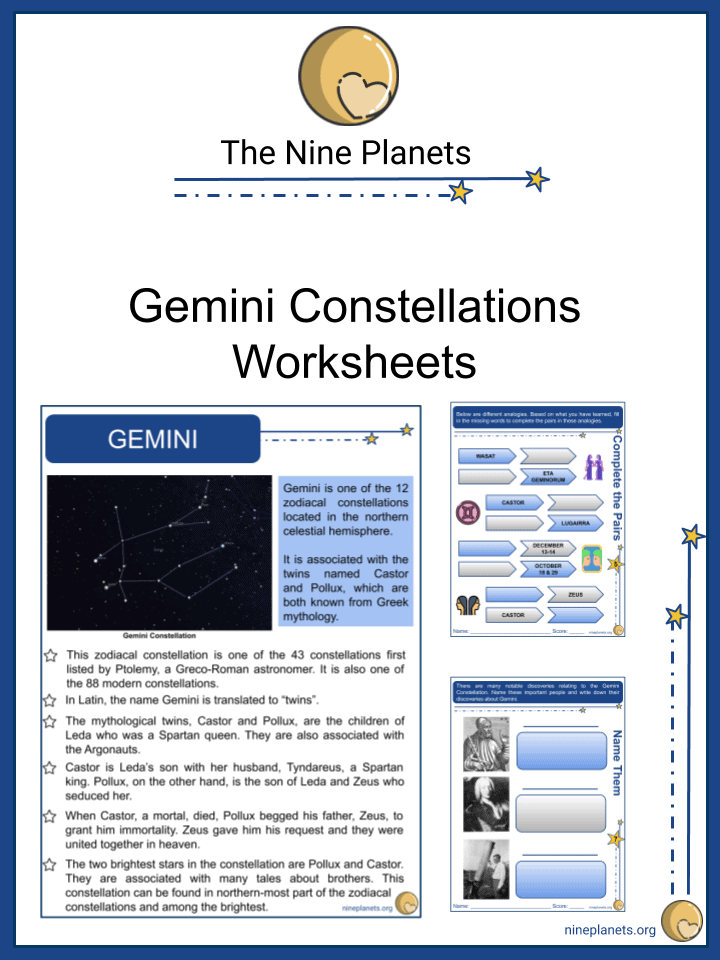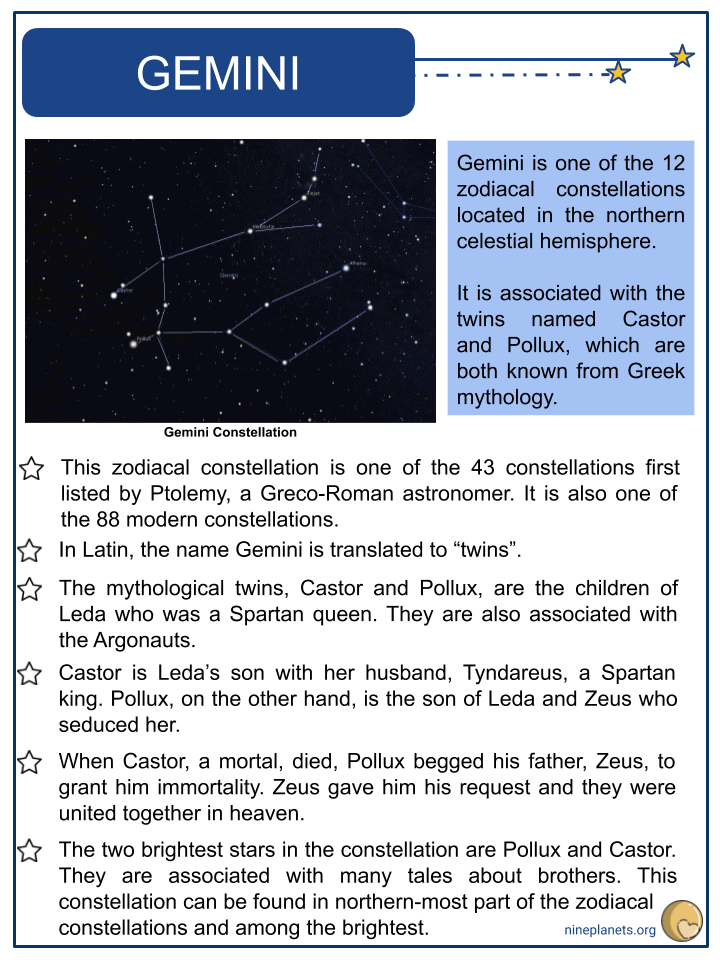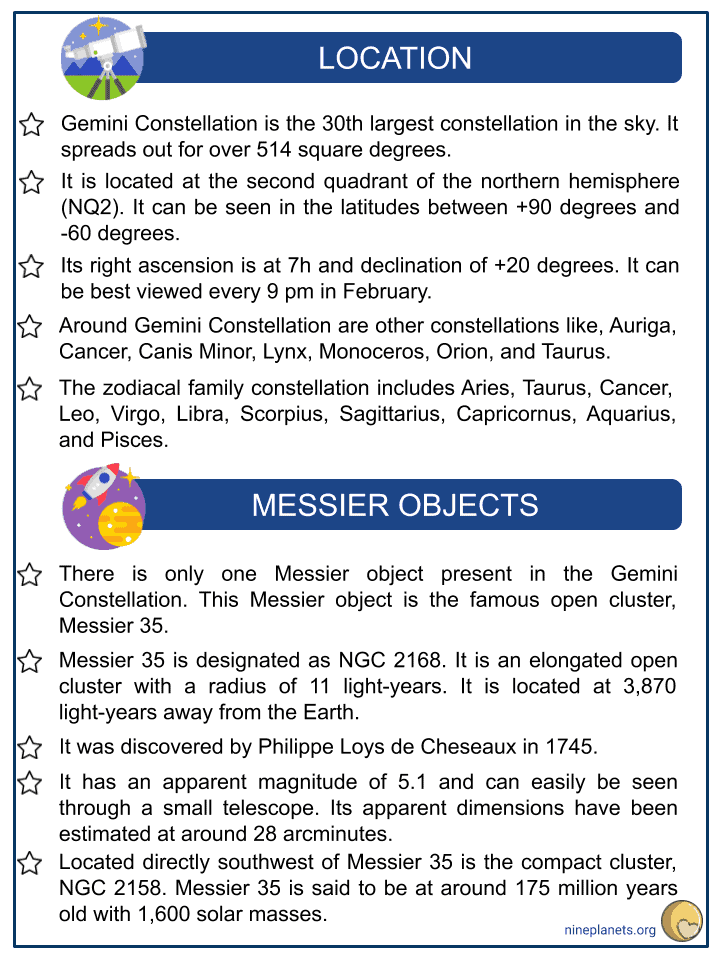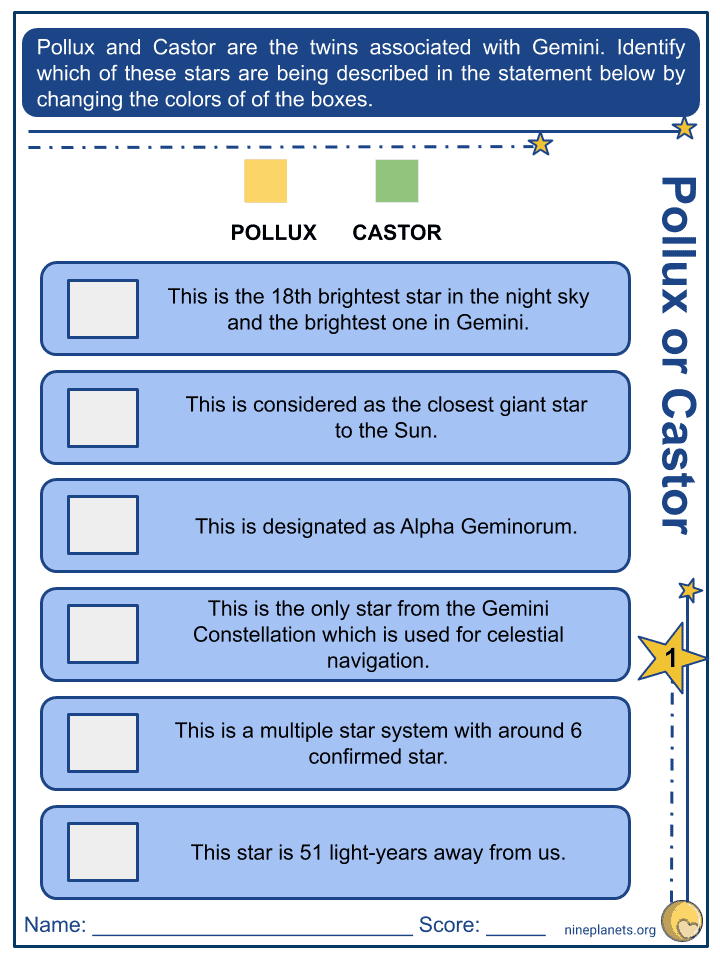Download Gemini Constellation Worksheets
Click the button below to get instant access to these premium worksheets for use in the classroom or at a home.

This worksheet can be edited by Premium members using the free Google Slides online software. Click the Edit button above to get started.
Download free sample
Not ready to purchase a subscription yet? Click here to download a FREE sample of this worksheet pack.
Resource Examples
Click any of the example images below to view a larger version.




Key Facts & Information
- Gemini is one of the 12 zodiacal constellations located in the northern celestial hemisphere.
- It is associated with the twins named Castor and Pollux, which are both known from Greek mythology.
- This zodiacal constellation is one of the 43 constellations first listed by Ptolemy, a Greco-Roman astronomer. It is also one of the 88 modern constellations.
- In Latin, the name Gemini is translated to “twins”.
- The mythological twins, Castor and Pollux, are the children of Leda who was a Spartan queen. They are also associated with the Argonauts.
- Castor is Leda’s son with her husband, Tyndareus, a Spartan king. Pollux, on the other hand, is the son of Leda and Zeus who seduced her.
- When Castor, a mortal, died, Pollux begged his father, Zeus, to grant him immortality. Zeus gave him his request and they were united together in heaven.
- The two brightest stars in the constellation are Pollux and Castor. They are associated with many tales about brothers. This constellation can be found in northern-most part of the zodiacal constellations and among the brightest.
Location
- Gemini Constellation is the 30th largest constellation in the sky. It spreads out for over 514 square degrees.
- It is located at the second quadrant of the northern hemisphere (NQ2). It can be seen in the latitudes between +90 degrees and -60 degrees.
- Its right ascension is at 7h and declination of +20 degrees. It can be best viewed every 9 pm in February.
- Around Gemini Constellation are other constellations like, Auriga, Cancer, Canis Minor, Lynx, Monoceros, Orion, and Taurus.
- The zodiacal family constellation includes Aries, Taurus, Cancer, Leo, Virgo, Libra, Scorpius, Sagittarius, Capricornus, Aquarius, and Pisces.
Messier Objects
- There is only one Messier object present in the Gemini Constellation. This Messier object is the famous open cluster, Messier 35.
- Messier 35 is designated as NGC 2168. It is an elongated open cluster with a radius of 11 light-years. It is located at 3,870 light-years away from the Earth.
- It was discovered by Philippe Loys de Cheseaux in 1745.
- It has an apparent magnitude of 5.1 and can easily be seen through a small telescope. Its apparent dimensions have been estimated at around 28 arcminutes.
- Located directly southwest of Messier 35 is the compact cluster, NGC 2158. Messier 35 is said to be at around 175 million years old with 1,600 solar masses.
Notable Stars
- The Gemini Constellation is composed of many different interesting stars, but it is dominated by Pollux and Castor. Pollux is considered as the brightest star in this constellation.
- POLLUX
- This is designated as Beta Geminorum. It is considered as the 18th brightest star in the night sky and the brightest one in the constellation of Gemini. It has an apparent magnitude of 1.14.
- It is an evolved giant star which is orange in color. It is also the closest giant star from the Sun and is only 33.78 light-years away from our Solar System.
- Pollux has around 191% of the Sun’s mass, 906% of its radius. It is also 32.7 times brighter than our Sun. It is cooler than the Sun with a temperature of 4,586 K.
- Pollux has been one of the stable anchor points by which other stars are classified ever since 1943. In 2006, an exoplanet was discovered orbiting this giant star and it was named Pollux b.
- Pollux b has an estimated mass of around 2.3 times that of Jupiter. It orbits the main star every 560 years.
- Pollux is the only star from Gemini which is part of the 58 stars chosen for celestial navigation.
- The stars, together with Pollux and others like Capella, Aldebaran, Sirius, and Procyon, are all part of the winter asterism, which is known as Winter Circle or Winter Hexagon.
- CASTOR
- Castor is designated as the Alpha Geminorum. It is considered as the second-brightest star in the Gemini Constellation. Its distance from the Earth is at around 51 light-years away and it has a magnitude of 1.93.
- This is a multiple star system. It has around six confirmed stars. The most prominent among the stars are the two A-class main-sequence stars with red dwarf companions.
- Alpha Geminorum Aa has around 276% of the Sun’s mass and 240% of its radius. It is also twice as hot as the Sun with a temperature of 10,286 K.
- Alpha Geminorum Ba is the largest star in this system with a mass of 298% of the Sun and the radius of 330% of the Sun. It has a surface temperature of 8,842 K.
- The Castor star system is the 23rd brightest star/object in the night sky.
- ALHENA
- It is designated as Gamma Geminorum, the third-brightest star in Gemini. It is a blue evolving star and is 109 light-years away from the Earth.
- It has a magnitude of 1.9 and is 123 times brighter than the Sun.It also has 281% of the Sun’s mass, and 330% of its radius. Its temperature is at 9,260 K, which makes it very hot.
- WASAT
- This star is designated as the Delta Geminorum. This star system is composed of a subgiant star, a cooler K-type companion, and a third one remains hard to be established.
- The star system has a combined visual magnitude of +3.53. The magnitude of the primary star has 157% of the Sun. It has a temperature of 6,900K, which makes it hotter than the Sun. It is 60.5 light-years away from the Sun.
- MEBSUTA
- It is a yellow supergiant which is designated as the Epsilon Geminorum. It is 840 light-years away from us. It has an apparent magnitude of +3.06.
- This star is indeed very big with 1,920% of our Sun’s mass, and radius of 14,000%, and it is 8,500 times brighter than the Sun.
- MEKBUDA
- It is a bright classical Cepheid variable star and is designated as the Zeta Geminorum. It has an apparent magnitude of 3.93 varying from 3.68 to 4.16 in a period of 10.148 days.
- Mekbuda is 1,120 light-years away from the Earth. It has around 770% of the Sun’s mass, its radius is 6,524% of the Sun. Overall, it is 2,900 times brighter than the Sun.
- PROPUS
- It is designated as the Eta Geminorum. It is also a triple star system and is located 700 light-years away from us. Its magnitude is at 3.15. The primary star, Propus Aa, is around 250% of the mass of the Sun, radius of 34,000% of the Sun’s and 12, 823 times brighter than the Sun.
- TEJAT
- Tejat is designated as Mu Geminorum. This is considered as the fourth-brightest star in the constellation. It has an apparent magnitude of 2.857 and is 230 light-years away from the Earth.
- It has 201% of the Sun’s mass, 8,000% of its radius and also 1,148 times brighter than the Sun. It is cooler than the Sun due its size with a temperature of around 3,460 K.
- KAPPA GEMINORUM
- This is a binary star system with its primary star having a magnitude of 3.568, while its secondary star is an eight magnitude star. This binary star system is located 141 light-years away from the Earth.
- Kappa Geminorum has 207% of the Sun’s mass, 1,100% of its radius and also 67.6 times brighter than it. It also served as one of the anchor points when identifying other stars.
- NU GEMINORUM
- This is also a binary star system and is possible to be a multiple star system. It has a magnitude of 4.16 and located 540 light-years away from us.
- Nu Geminorum Aa, the primary star, has 640% of the Sun’s mass. It is also 1,138 times brighter than the Sun. It is three times as hot as the Sun with a temperature of 14,100 K.
- Not much is known about Nu Geminorum Ab aside from its mass, which is 460% of our Sun’s mass.
- 38 GEMINORUM
- This is also known as e Geminorum. This is also a binary star. Its primary star is located 96 light-years away from us, while the secondary star is located 97.9 light-years away.
- A is a A-type main-sequence star and has a magnitude of 4.75. It has around 155% of the Sun’s mass, on the other hand, B is a G-type main-sequence star with a magnitude of 7.80.
- U GEMINORUM
- This is also a binary star system wherein a white dwarf can be seen orbiting a red dwarf. This is an example of a dwarf nova.
- It is located 304.5 light-years away from us. Its primary star has a magnitude of 8.2 while the secondary star has 14.9.
- The stars orbit one another once every 4 hours and 11 minutes. This causes their difference in brightness due to the eclipses.
- The white dwarf is the primary star. It has 120% of the Sun’s mass, and only 0.008% of its radius. It is five times hotter with a temperature of 29,200 K. The red dwarf, on the other hand, is much smaller than the Sun with only 42% of its mass and 43% of its radius.
Deep-Sky Objects
- ESKIMO NEBULA
- It is also known as Clownface Nebula or Caldwell 39. It is a bipolar double-shell planetary nebula that can be found in Gemini. It is located 6,521 light-years away from us.
- It resembles a person’s head. Its outer gas was once a part of the layers of a Sun-like star.
- The Eskimo Nebula was discovered by William Herschel in 1787. It can be seen using a small telescope.
- This nebula has magnitude of 10.1 and a radius of around 0.34 light-years.
- MEDUSA NEBULA
- Medusa Nebula is also referred to as Abell 21 or Sharpless 2-274. It is a planetary nebula which was discovered by an astronomer named George O. Abell in 1955.
- This nebula is located at around 1,500 light-years away from us and stretches for 3 more light-years. It has a magnitude of 15.99.
- JELLYFISH NEBULA
- This nebula is also known as IC 443 or Sharpless 248. It is a galactic supernova remnant located 5,000 light-years away from us.
- It is believed that to be a remnant of a supernova that occured 3,000 to 30,000 years ago.
- It has an angular diameter of around 50 arcminutes/70 light-years. One of its notable features is its interaction with the molecular clouds.
- IC 444
- This is a small reflection nebula in Gemini. It stretches out for around 32 square arcminutes. Its apparent magnitude is 7.03.
- GEMINGA
- Geminga is a neutron star located at 815 light-years away from us. It may be a collapsed remnant of a stellar core due to a supernova explosion which occurred 300,000 years ago.
- It was the first to be discovered unidentified gamma-ray source.
- It was also the first example of a radio-quiet pulsar with a magnitude of 22.5
- NGC 2158
- This is an open cluster which is located at southwest of Messier 35 and is believed to be 2 billion years old.
- It is located 11,000 light-years away from us, extending around 5 arcminutes. It has a magnitude of 8.6 and a radius of 8 light-years.
- NGC 2129
- This is also an open cluster which is located 7,200 light-years away from us and located in the Local Spiral arm of the Milky Way.
- This is quite young with an estimated age of around 10 million years old.
- It has a estimated radius of 5.2 light-years and an apparent magnitude of 6.7. It is dominated by two close B-type stars.
- NGC 2355
- This is an open cluster which is around one billion years old. It is located 5,400 light-years away from the Earth.
- It can be seen at 1,100 light-years away from the plane of the Milky Way.
- The angular size of the halo of this cluster is at a radius of 23 light-years away.
- Its core radius is 2.3 light-years away and its central component radius is 11 light-years.
- It has an apparent magnitude of 9.7. Its overall apparent dimension is of 5 arcminutes.
Meteor Showers
- The Gemini Constellation is associated with two prominent meteor showers. These meteor showers are called Geminids and Rho Geminids.
- The Geminids are very bright and usually peak every December 13–14. While Rho Geminids peak October 18 and 29.
- Geminids is considered as one of the richest meteor showers. Around 100 meteors per hour have been recorded during its peak. Rho Geminids overlaps with the Orionids. This makes them difficult to be seen and detected. Despite this, they still have a higher velocity than Orionids.
Astrology
- Since 2002, the Sun appears in the Gemini Constellation every June 21 to July 20. In tropical astrology, the sign of Gemini is the Sun from May 21 to June 22. In sidereal astrology, every June 16 to July 15.
Did You Know?
- In Chinese astronomy, the stars are located in White Tiger of the West, and the Vermillion Bird of the South.
- Uranus was discovered by William Herschel in 1781 near Propus. When Clyde Tombaugh exposed photographic plates centered on Propus, he discovered Pluto in 1930.
- Castor and Pollux are known as the Great Twins. They are called Meshlamtea and Lugairra in Babylonian astronomy, which means “The One Who had Risen from the Underground” and the “Mighty King”. They can be understood as titles of Nergal, the major Babylonian god of plague and pestilence.